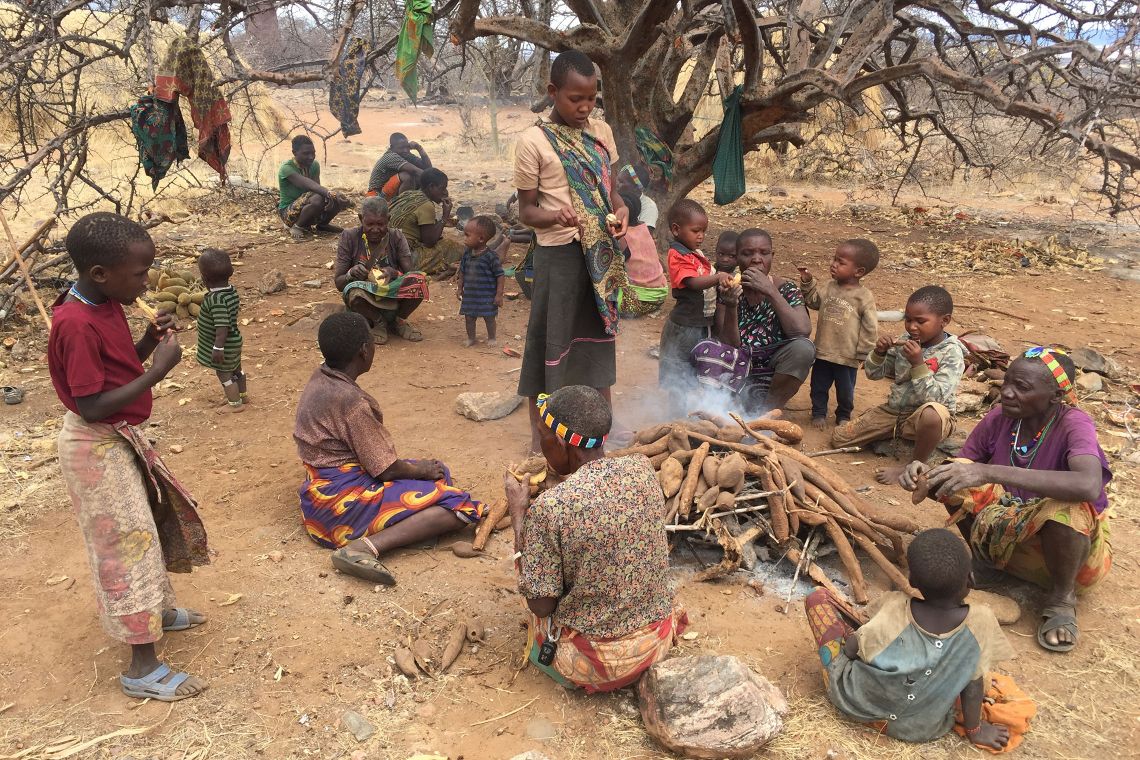Risky Food-Finding Strategy Could be the Key to Human Success
Creative free time may have come from big meals that could be shared

DURHAM, N.C. – It’s a cold and rainy Sunday afternoon: would you rather be running after tasteless wild berries, or curled up on your couch with fuzzy socks and a good book?
You might not have had that choice if our ancestors had not taken a big gamble with their food.
A new study published in Science on Dec. 24 shows that early human foragers and farmers adopted an inefficient high-risk, high-reward strategy to find food. They spent more energy in pursuit of food than their great ape cousins, but brought home much more calorie-rich meals that could be shared with the rest of their group. This strategy allowed some to rest or tackle other tasks while food was being acquired.
“Hunting and gathering is risky and inefficient, but the rate of return is enormous,” said study co-leader, Herman Pontzer, an associate professor of Evolutionary Anthropology at Duke University. “We can share our food, and because we got so many calories before noon, we can hang out around each other in this new space, a free-time space.”
Humans spend a lot more energy than great apes. We have big brains that eat up a lot of calories, we live a long time, we can have long pregnancies that produce big babies, and these babies rely on adults for a long time.
To find out how humans obtained this extra energy, a group of researchers led by Thomas Kraft, a postdoctoral researcher at the University of California Santa Barbara, and Pontzer compared the energy budgets of wild gorillas, chimpanzees and orangutans with that of populations of Tanzanian hunter-gatherers (Hadza) and Bolivian forager-horticulturalists (Tsimane).
Hunter-gatherers and forager-horticulturalists both gather food from wild plants and animals, but the Tsimane also produce small-scale crops.
Energy budgets depend on how much food energy is absorbed, and how much time and energy are spent obtaining food. Humans were thought to maintain their energetically costly lifestyle in one of two ways: they could be super-efficient, spending little time and energy finding food – in part due to the use of tools and technological advances, or they could spend a lot of energy to quickly bring home a lot of food, sacrificing energy efficiency.
The researchers found that hunter-gatherers and forager-horticulturalists are inefficient, high-intensity foragers. Like a gas-guzzling pick-up truck bringing home a ton of donuts, they spend a lot more energy obtaining food than great apes, but they do it faster and the food they obtain is high in calories. Rather than minimizing their costs, they take a risk to maximize their rewards.
Chimpanzees, gorillas and orangutans, on the other hand, are like an electric car bringing home a head of lettuce and some apples. They are essentially herbivores and frugivores who eat very little, if any, meat. Their strategy is one of low risk, low rewards: their food is easy to find, but it’s fibrous, low in energy, and it takes a lot of time to get enough of it.
The Hadza hunter-gatherers and the Tsimane forager-horticulturalists both eat high-calorie foods that are harder to get. They spend a lot of energy hunting, gathering, planting and harvesting, but can quickly bring home a nutritious lunch. What’s more, they bring enough to share.
Pontzer said sharing provides a safety net, enabling some group members to take risks, targeting big game and other high-risk, high-reward foods. If they come home empty-handed, which they often do, they know others will have something to share. The possibility of sharing food also means some group members can even stay at the camp on occasion, enjoying one of our most precious commodities: free time.
“This slight shift in the way that we go about getting our food has fundamentally made everything else possible,” Pontzer said. Free time allows group members to communicate about things other than food. It allows for experimentation, for learning, for creativity, for play, for culture.
Being wired to finding and sharing energy bombs was, and still is, a winning strategy for hunter-gatherers and foragers-horticulturalists, Pontzer said. But it also can be treacherous for those of us with a pantry full of delicious highly caloric food.
“We are built to try and get a lot of food,” Pontzer said. “We are hugely ravenous and inefficient, and that's how we've evolved for 2 million years.”
“That doesn’t mean we can be careless with our energy today, and it doesn't mean that we have to say, ‘well there's nothing we can do about it’,” Pontzer said. “We have to be aware of ourselves and our evolutionary history.”
This research was Supported by the National Science Foundation (BCS0422690, BCS-0850815, BCS-1440867, BCS-1062879, BCS-1440841, BCS-1440671, BCS-0242455), NIH (R01AG024119, R56AG024119), the Leakey Foundation, the Max Planck Institute for Evolutionary Anthropology, the University of California, San Diego, and the American School of Prehistoric Research (Harvard University), as well as IAST funding from ANR under grant ANR-17-EUR-0010 (Investissements d’Avenir program).
CITATION: “The Energetics of Uniquely Human Subsistence Strategies,” Thomas S. Kraft, Vivek V. Venkataraman, Ian J. Wallace, Alyssa N. Crittenden, Nicholas B. Holowka, Jonathan Stieglitz, Jacob Harris, David A. Raichlen, Brian Wood, Michael Gurven, Herman Pontzer. Science, 374 (6575), eabf0130. Decemer 2021. DOI: 10.1126/science.abf0130